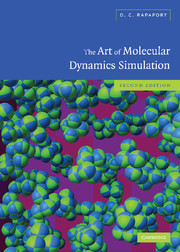Book contents
- Frontmatter
- Contents
- Preface to the first edition
- Preface to the second edition
- About the software
- 1 Introduction
- 2 Basic molecular dynamics
- 3 Simulating simple systems
- 4 Equilibrium properties of simple fluids
- 5 Dynamical properties of simple fluids
- 6 Alternative ensembles
- 7 Nonequilibrium dynamics
- 8 Rigid molecules
- 9 Flexible molecules
- 10 Geometrically constrained molecules
- 11 Internal coordinates
- 12 Many-body interactions
- 13 Long-range interactions
- 14 Step potentials
- 15 Time-dependent phenomena
- 16 Granular dynamics
- 17 Algorithms for supercomputers
- 18 More about software
- 19 The future
- Appendix
- References
- Function index
- Index
- Colophon
3 - Simulating simple systems
Published online by Cambridge University Press: 28 February 2011
- Frontmatter
- Contents
- Preface to the first edition
- Preface to the second edition
- About the software
- 1 Introduction
- 2 Basic molecular dynamics
- 3 Simulating simple systems
- 4 Equilibrium properties of simple fluids
- 5 Dynamical properties of simple fluids
- 6 Alternative ensembles
- 7 Nonequilibrium dynamics
- 8 Rigid molecules
- 9 Flexible molecules
- 10 Geometrically constrained molecules
- 11 Internal coordinates
- 12 Many-body interactions
- 13 Long-range interactions
- 14 Step potentials
- 15 Time-dependent phenomena
- 16 Granular dynamics
- 17 Algorithms for supercomputers
- 18 More about software
- 19 The future
- Appendix
- References
- Function index
- Index
- Colophon
Summary
Introduction
In this chapter we focus on a number of techniques used in MD simulation, primarily the methods for computing the interactions and integrating the equations of motion. The goal is to generate the atomic trajectories; subsequent chapters will deal with the all-important question of analyzing this raw ‘experimental’ data. We continue to work with the simplest atomic systems, in other words, with monatomic fluids based on the LJ potential, not only because we want to introduce the methodology gradually, but also because a lot of the actual qualitative (and even quantitative) behavior of many-body systems is already present in this simplest of models. Models of this kind are widely used in MD studies of basic many-body behavior, examples of which will be encountered in later chapters.
Equations of motion
While Newton's second law suffices for the dynamics of the simple atomic fluid discussed in this chapter, later chapters will require more complex forms of the equations of motion. The Lagrangian formulation of classical mechanics provides a general basis for dealing with these more advanced problems, and we begin with a brief summary of the relevant results. There are, of course, other ways of approaching the subject, and we will also make passing reference to Hamilton's equations. A full treatment of the subject can be found in textbooks on classical mechanics, for example [go180].
- Type
- Chapter
- Information
- The Art of Molecular Dynamics Simulation , pp. 44 - 82Publisher: Cambridge University PressPrint publication year: 2004



